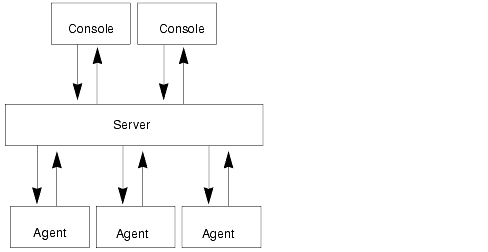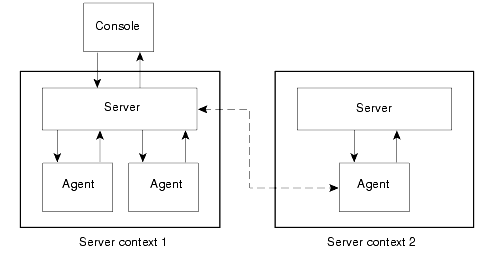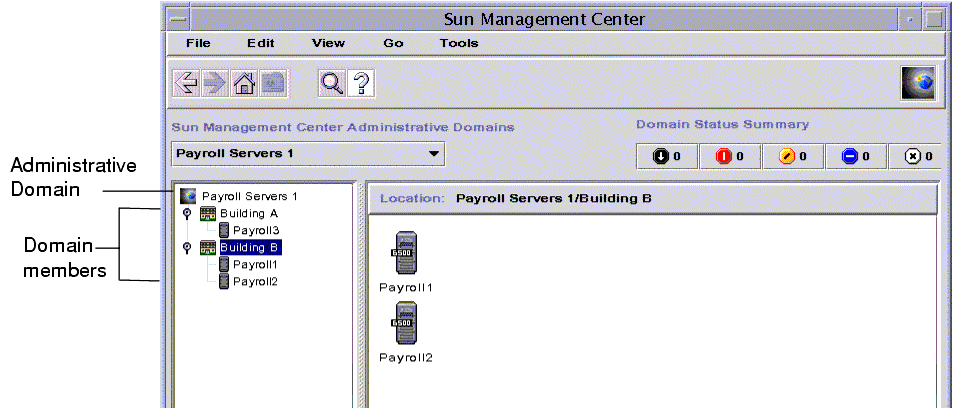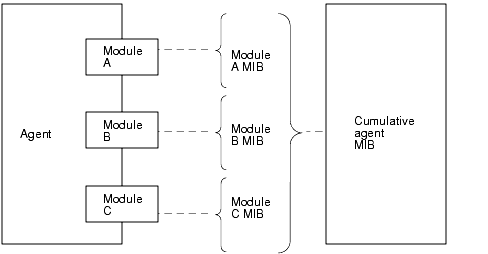









Chapter 1 |
Introduction |
This chapter provides an overview of the SunTM Management Center version 3.0 product, its component layers, and how they interact with one another.
This chapter includes the following topics:
Sun Management Center software is an open, extensible system monitoring and management solution that uses JavaTM software protocol and Simple Network Management Protocol (SNMP) to provide an integrated and comprehensive enterprise-wide management of Sun products and their subsystems, components, and peripheral devices.
Sun Management Center technology provides a solution to extend and enhance the management capability of Sun's hardware and software solutions.
Sun Management Center software comprises three component layers: console, server, and agent. It is based on the manager/agent architecture, in which:
The three component layers are depicted in FIGURE 1-1.

The major Sun Management Center layers and their functionality are described below.
You may have multiple consoles, serving multiple users, for the same Sun Management Center server. The consoles provide you with:
The Sun Management Center console layer is the interface between you and the other component layers of Sun Management Center software.
The server layer accepts requests from you through the console and passes these requests to the appropriate agent. It then relays the response from the agent back to you.
For example, if you want information on the number of users accessing a host, the server layer receives this request from the console, and sends it to the agent on that host. The agent finds the answer, sends it back to the server, which passes on the information to you (through the console)
Similarly, if an error condition is created on one of the hosts, the agent on that host sends notification of this error (an event) to the server, which forwards the information to you (through the console) as an alarm.
In addition, this layer provides the console with a secure entry point to interface with the agents.
The server layer includes five components (FIGURE 1-2):

The server component is the core of the server layer. It is based on Java technology and is multi-threaded, and it handles multiple data requests from various Sun Management Center users.
Sun Management Center Topology manager provides services including the management of user administrative domains and the topology layout of managed objects.
The Trap handler is a centralized SNMP trap receptor that performs logging and forwarding of traps to interested components. It is this server layer component that is responsible for receiving all alarm notifications.
The Sun Management Center Configuration manager provides security services to the server and the agents.
The Sun Management Center Event manager sends and receives event information from the agents. These events can trigger alarms, which are forwarded to the console.
The agent layer performs the actual information gathering, monitoring, and management of objects on the nodes managed by the Sun Management Center software. The server layer interacts with the agent layer to gain access to the managed objects by using SNMP.
Sun Management Center agents are scalable, extensible, and SNMP-based. They monitor and manage objects including hardware, operating systems, and applications by loading modules that focus on a specific aspect of the system, as well as application health and performance.
The agents use rules to determine the status of the managed objects. When the conditions specified by a rule become true, the software automatically generates alarms or performs actions as specified in the rules.
A Sun Management Center server context is defined as the server layer and the agent layers. When starting the console, you log into a particular server context. The managed objects whose agents send information to that same server also belong to the same server context.
A managed object can belong to the same server context or a remote server context. (A managed object in a remote server context sends information to a different server while a managed object in the same server context sends information to the server host that is connected to your console.)
By default, the Sun Management Center software manages an object in the same server context but only monitors an object in a remote server context. For a precise definition of manage and monitor, see the Glossary. For more information on the server context, see Chapter 14.

The following concepts are fundamental to understanding Sun Management Center software:
Note - In this document, "domain" refers to a Sun Management Center administrative domain, and should not be confused with uses of the term "domain" related to other Sun products or documentation. See Chapter 2 for more information.
An administrative domain is a hierarchical collection of resources that you want to monitor and manage. The resources can include a complete campus, individual buildings, hosts, networks, subnets, links, and so on. Each administrative domain may consist of these resources, which can be combined with other resources to form groups within a administrative domain. Each of these groups may contain additional groups of resources, providing a multilevel, hierarchical administrative domain.
You should create administrative domains based on your business needs. You can create one or more administrative domains. For example, you may create a lab administrative domain that contains all the lab machines. Similarly, you may create an accounting administrative domain that contains all the machines used for accounting.
The Sun Management Center software displays the administrative domain and its members in a visual representation (FIGURE 1-4).
In the following example, the host, Payroll2, belongs to the Building B group, which belongs to the Payroll Servers 1 administrative domain.

FIGURE 1-4 Sun Management Center Main Console Window Showing an Administrative Domain and Its Members
Unlike most agents, the Management Information Base (MIB) provided by Sun Management Center agents is not implemented in a monolithic code that contains a wide variety of functionality in a single program. Instead, Sun Management Center software uses several components, called modules, for each agent. Each module implements its own MIB. Therefore, the Sun Management Center agent MIB is the cumulative total of all the modules and their individual MIBs (FIGURE 1-5).

Sun Management Center modules monitor and manage the resources of systems, applications, and network devices.
The modules serve two purposes:
For more information on alarms, see"Alarms and Rules".
Each module consists of one or more properties that can be monitored on your system. For example, one of the default modules loaded during installation is the Kernel Reader. This module monitors kernel properties. These properties include user statistics, disk statistics, file system usage, and so on.
Note - You can add or remove modules dynamically. This feature enables you to customize the modules loaded on each agent (object), based on your need.
Sun Management Center software enables you to monitor your system with alarms of differing severities. The thresholds that generate these alarms are defined in the modules. The software enables you to set the thresholds that trigger simple alarms.
For example, one of the properties of the Kernel Reader module is the number of user sessions. The software enables you to set the threshold that generates the alarm. For example, you may tell Sun Management Center software to generate a critical alarm when there are seven or greater user sessions. Similarly, you may also tell the software to generate only a cautionary alarm when there are five-to-six user sessions.
Although the software is configured with default alarm conditions, you can set and define your own alarm thresholds for simple alarms such as those based on the simple rCompare (comparison) rule.
Complex rules also generate alarms. For example, one complex rule states that when a disk is over 75 percent busy, the average queue length is over 10 entries and the wait queue is increasing, then an alert alarm is generated. This rule combines three conditions:
Unlike simple rules, these complex rules are predefined and cannot be modified. Consequently, you cannot set thresholds for complex alarms.
When an alarm is generated, the software notifies you through the main console window, and with a message sent to a specified e-mail address. You can also write a customized program that will notify you in other ways that an alarm condition has occurred, such as sending a message to your pager.
For more information on alarms, see Chapter 12. For more information on rules, see Appendix E.
Sun Management Center software includes the following monitoring features:
These are graphical user interface or GUI-based features, except for autonomous agents. Security is both a GUI-based and command-line feature.
Sun Management Center agents work autonomously by actively sampling key data on host systems. These agents can be polled through SNMP get requests for the current status of the monitored data.
When an agent gathers data for a monitored resource, it checks the data against the alarm threshold set for the resource and determines whether the data values constitute an alarm condition. If the monitored data meets the alarm threshold, the agent performs the action associated with the alarm condition. Agents send asynchronous messages (SNMP traps) to the server, which delivers notification of the change in the status of the monitored data.
Sun Management Center software provides a main console window to depict, monitor, and interact with your system. You can monitor multiple administrative domains, spanning different locations, through multiple console windows.
Sun Management Center software offers both hierarchy and topology views (for every administrative domain) and hierarchy and contents views (for every object). The hierarchy enables you to navigate through the administrative domain or host to find the object of interest. The topology view or contents view displays the members of the object that is selected in the hierarchy.
For an administrative domain, the hierarchy and topology views are displayed in the main console window. In addition, you may customize the administrative domain topology view by adding a background or creating a connection between objects in the administrative domain.
For an object, the hierarchy and contents views are displayed in the Details window. The Details window consists of a series of tabs; the tabs are dependent on the type of object. For example, a typical host object contains the following tabs: Info, Browser, Alarms, View Log, Applications, and Hardware. The View Log, Applications View, and Hardware tabs are described briefly below.
The view log tab button enables you to view informational messages, including error messages, about your host.
This tab enables you to view and select detailed information about processes running on the selected host or node. If you have any custom or third-party applications installed, this tab also enables you to view detailed information about processes running in the selected custom applications or third-party applications. The displays are continually updated.
The physical view available from the hardware tab provides you with photo-realistic front, back, and side views of the host. With your mouse button, you can click on individual components of the host and see detailed information about that component. For example, you can click on a board in a server, and see detailed information about that board, such as CPUs, memory, and board temperature.
Note - Physical views are only available for some hardware platforms.
Sun Management Center software also provides a logical view of the overall hardware configuration of the host. Like the physical view, you can click on a single component and obtain detailed information about that hardware component.
Note - Logical views are only available for some hardware platforms.
Sun Management Center software enables you to create a two-dimensional graph of any monitored data property that has a numerical value.
The Sun Management Center security feature authenticates user login and access control privileges for users and groups. It enables users to set security permissions at the administrative domain, group, host, and module levels.
You can restrict access by setting different permissions. For example, one group of users can see and modify properties on a host while a second group of users can only see the host (with no modification privileges).
You can access Sun Management Center security features from the Attribute Editor within the software.
Sun Management Center software may be deployed in two different environments:
The production environment is an "active" or "real" environment in which you manage and monitor your hardware, including subsystems, components, and peripheral devices.
In contrast, the developer environment is a "test" or "demonstration" environment in which developers can test customized modules designed to work with the Sun Management Center software. While the developer environment may appear to be a production environment, its sole purpose is to serve as a "demo" environment for developers to create Sun Management Center modules. For more information on developer environments, refer to the Sun Management Center 3.0 Developer Environment Reference Manual.
For information on installing Sun Management Center 3.0, see the Sun Management Center 3.0 Software Installation Guide.
Note - For additional documentation describing new functionality, refer to the Sun Management Center Software Release Notes, which is located on the Sun Management Center web site: http://www.sun.com/sunmanagementcenter and on the Sun Management Center 3.0 CD.
Sun Management Center supports multiple hardware platforms. Refer to the Sun Management Center Configuration and Deployment Guide on the Sun Management Center web site for more information on the supported hardware platforms: http://www.sun.com/sunmanagementcenter.
This Sun Management Center 3.0 Software User's Guide describes the software functionality that is common to all the supported hardware platforms while platform-specific information is included in the supplements. For example, Sun Management Center functionality specific to the SPARCserverTM 1000 and 1000E, the SPARCcenterTM 2000 and 2000E, and the Sun EnterpriseTM 6x00/5x00/4x00/3x00 is contained in the Sun Management Center 3.0 Supplement for Sun Enterprise Midrange Servers. This supplement is located on the Sun Management Center web site: http://www.sun.com/sunmanagementcenter and in the Sun Management Center 3.0 CD.
Note - For complete information on how you can use the Sun Management Center software to manage and monitor your machines, read both this user's guide and the hardware supplement applicable to your machines.
After installing Sun Management Center software, spend some time navigating through the various windows and testing their functionality. By exploring and testing the software, you will have a better understanding of how you can customize Sun Management Center software to aid in your system monitoring. See Appendix A for more information.
If you prefer to set up your monitoring environment now, see Chapter 14 for information on security.
This documentation includes a description of basic and advanced features available in the Sun Management Center version 3.0 software product. The features available in your installation of the product are highly dependent on the terms of your site license. Your installation of the product may or may not include all features.




